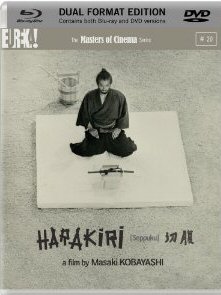
(A.k.a. SEPPUKU)
We first meet Tsugumo (Tatsuya Nakadai) when he’s at his lowest ebb, a former Ronin who has become detached from his clan and has been reduced to wandering the land in a state of perpetual poverty.
He lands on the doorstep of the House of Lord Ivi, and is granted counsel with its apparently understanding senior member Saito. Explaining that a period of peace in 17th Century Japan has resulted in his clan’s talents no longer being profitable, Tsugumo begs a favour – he wishes the permission of the feudal Lord for him to commit hara-kiri (suicide through self-evisceration), thus dying an honourable death fitting of his profession and beliefs.
Saito remains calm while listening, but then tells of how things turned out badly for the last samurai to turn up at the house requesting the same thing. His name was Motome (Akira Ishihama), and the flashbacks through his storytelling reveal how Motome came seeking employment ... but ultimately ended up paying the ultimate price for his needs.
Saito’s story is certainly a sombre warning for those who wish to tread a similar path.
But, for reasons he’d rather not share, Tsugumo seems resolute on ending his life at the House of Lord Ivi. Or so it would seem. As he begins to share his own story, his motives for appearing at the Lord’s property become clearer ...
HARAKIRI doesn’t need much of a synopsis. The storyline is fairly basic, despite the film’s 133 minute running time. It could be argued that the pace is fairly slow for the first half – it’s certainly talky enough – but, from the start, this is a wonderfully expressive and imposing film of themes and atmosphere.
The dying of old traditions and a lack of connection, or respect, between old worlds and new are issues that hang heavy over Masaki Kobayashi’s 1962 film. Pride, honour, desperation: these are all examined too, as is that old favourite of samurai cinema – revenge.
The performances are largely negligible, although Nakadai (RAN; YOJIMBO) is as brilliant as ever, injecting equal amounts of warmth and venom into his brooding role. What really makes HARAKIRI though, other than Kobayashi’s masterful handling of pace – building leisurely towards a true sense of impending doom that never lets up – is Yoshio Miyajima’s sterling cinematography. He frames and captures every scene wonderfully, making this one of the most striking monochrome films in recent memory. It’s beautiful, even when you’re wrapped in the action that gradually mounts.
For a film that’s knocking on being 50 years old, HARAKIRI is also unexpectedly contemporary in feel at times. The first suicide scene is graphic, managing to shock by virtue of its surprisingly gory, drawn out nature. It also has pathos thrown in to it, lending the scene a sense of theatrical drama about it that almost reaches Shakespearian levels.
It’s a perfect appetiser for a film that is going to shift from low-key dynamics to serious revenge action in its final act. And it’s a thrilling ride getting there.
HARAKIRI comes to UK DVD via Eureka uncut in a spiffing new 2.35:1 transfer that has been enhanced for 16x9 television sets. Contrast is amazing, adding real depth to each scene while never allowing for distracting shimmer. Blacks are solid throughout, images are sharp but natural and a very fine layer of grain remains for that authentic filmic touch.
It’s been reported that this new transfer offers more screen information than Criterion’s Region 1 DVD release, at both sides of the screen. It’s a surprising claim, but one that does seem to carry weight. All I know is this looks perfectly framed and the picture presentation throughout is wholly satisfying.
Japanese 2.0 audio is also a healthy proposition for the duration of the film. Easily readable English subtitles can be chosen from the main menu page.
Speaking of which, the disc opens with a static main menu page. From there a basic, static scene-selection menu allows access to the main feature via 12 chapters.
Extras begin with a 1993 interview with Kobayashi, filmed for the Director’s Guild at the Haiyuza Theatre in Tokyo. The interview is conducted on video by fellow film director Masahiro Shinoda. It’s an excellent, laid-back 9-minute chat that comes rife with humour and candour. Presented in Japanese with English subtitles.
We also get the film’s original 3-minute Japanese trailer, presented in anamorphic widescreen and looking pretty good – albeit a lot rougher than the main feature’s presentation. Again, this has been graced with English subtitles.
Also included in the set but unavailable for review purposes is a 28-page booklet with rare production stills, another Kobayashi interview and liner notes from Philip Kemp.
The film is being released by Eureka’s Masters of Cinema series as a blu-ray/DVD dual format release. Only the DVD was made available to review.
A highly recommended release.
By Stuart Willis
| Released by Eureka Entertainment |
| Region 2 - PAL |
| Rated 18 |
| Extras : |
| see main review |